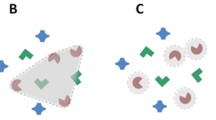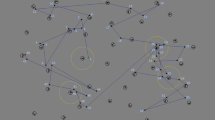Abstract
A single eye fixation encompasses approximately 25,000 square degrees of the visual world, roughly 180° horizontally by 130° vertically (Harrington, 1981). The quality of the visual information that is available in this total area is quite variable, however. The area that is seen most clearly, with the highest resolution, corresponds to that part of the world that falls on the fovea, but this includes only 3 or 4 square degrees out of the 25,000 that are available. Visual acuity drops off very rapidly with increasing retinal eccentricity, being reduced by 50% at a distance of 5° from the fovea and by 90% at 40° (Hochberg, 1978). Because of these acuity limitations, humans make eye, head, and body movements to fixate objects of interest in the world; somehow the contents of these successive fixations must be combined across movements to produce a coherent representation of the visual environment. How this combination is accomplished has puzzled psychologists and vision researchers for over a century.
Access this chapter
Tax calculation will be finalised at checkout
Purchases are for personal use only
Preview
Unable to display preview. Download preview PDF.
Similar content being viewed by others
References
Adelson, E.H., & Jonides, J. (1980). The psychophysics of iconic storage. Journal of Experimental Psychology: Human Perception and Performance, 6, 486–493.
Allen, F. (1926). The persistence of vision. American Journal of Physiological Optics, 7, 439–457.
Banks, W.P. (1983). On the decay of the icon. Behavioral and Brain Sciences, 6, 14.
Bowen, R.W., Pola, J., & Matin, L. (1974). Visual persistence: Effects of flash luminance, duration, and energy. Vision Research, 14, 295–303.
Breitmeyer, B.G. (1984). Visual masking: An integrative approach. New York: Oxford University Press.
Breitmeyer, B.G., Kropfl, W., & Julesz, B. (1982). The existence and role of retinotopic and spatiotopic forms of visual persistence. Acta Psychologica, 52, 175–196.
Bridgeman, B., & Mayer, M. (1983). Failure to integrate visual information from successive fixations. Bulletin of the Psychonomie Society, 21, 285–286.
Coltheart, M. (1980). Iconic memory and visible persistence. Perception & Psychophysics, 27, 183–228.
Coltheart, M., Lea, CD., & Thompson, K. (1974). In defence of iconic memory. Quarterly Journal of Experimental Psychology, 26, 633–641.
Davidson, M.L., Fox, M.J., & Dick, A.O. (1973). Effect of eye movements on backward masking and perceived location. Perception & Psychophysics, 14, 110–116.
Dick, A.O. (1969). Relations between the sensory register and short-term storage in tachistoscopic recognition. Journal of Experimental Psychology, 82, 279–284.
Dick, A.O. (1974). Iconic memory and its relation to perceptual processes and other mechanisms. Perception & Psychophysics, 16, 575–596.
Di Lollo, V. (1977). Temporal characteristics of iconic memory. Nature, 267, 243–243.
Di Lollo, V. (1980). Temporal integration in visual memory. Journal of Experimental Psychology: General, 109, 75–97.
Efron, R. (1970). Effect of stimulus duration on perceptual onset and offset latencies. Perception & Psychophysics, 8, 231–234.
Eriksen, C.W., & Collins, J.F. (1967). Some temporal characteristics of visual pattern perception. Journal of Experimental Psychology, 74, 476–484.
Eriksen, C.W., & Collins, J.F. (1968). Sensory traces versus the psychological moment in the temporal organization of form. Journal of Experimental Psychology, 77, 376–382.
Friedman, A. (1979). Framing pictures: The role of knowledge in automatized encoding and memory for gist. Journal of Experimental Psychology: General, 108, 316–355.
Haber, R.N., & Standing, L. (1970). Direct estimates of the apparent duration of a flash. Canadian Journal of Psychology, 24, 216–229.
Harrington, D.O. (1981). The visual fields: A textbook and atlas of clinical perimetry. St. Louis, MO: Mosby.
Hayhoe, M., Lachter, J., & Feldman, J. (1991). Integration of form across saccadic eye movements. Perception, 20, 393–402.
Hochberg, J. (1978). Perception. Englewood Cliffs, NJ: Prentice-Hall.
Intraub, H. (1980). Presentation rate and the representation of briefly glimpsed pictures in memory. Journal of Experimental Psychology: Human Learning and Memory, 6, 1–12.
Intraub, H. (1984). Conceptual masking: The effects of subsequent visual events on memory for pictures. Journal of Experimental Psychology: Learning, Memory, and Cognition, 10, 115–125.
Irwin, D.E. (1991). Information integration across saccadic eye movements. Cognitive Psychology, 23, 420–456.
Irwin, D.E. (in press). Perceiving an integrated visual world. In D.E. Meyer and S. Kornblum (Eds.), Attention and performance Vol. XIV: A silver jubilee. Cambridge, MA: MIT Press.
Irwin, D.E., & Brown, J.S. (1987). Tests of a model of informational persistence. Canadian Journal of Psychology, 41, 317–338.
Irwin, D.E., Brown, J.S., & Sun, J.S. (1988). Visual masking and visual integration across saccadic eye movements. Journal of Experimental Psychology: General, 117, 276–287.
Irwin, D.E., Yantis, S., & Jonides, J. (1983). Evidence against visual integration across saccadic eye movements. Perception & Psychophysics, 34, 49–57.
Irwin, D.E., & Yeomans, J.M. (1986). Sensory registration and informational persistence. Journal of Experimental Psychology: Human Perception and Performance, 12, 343–360.
Irwin, D.E., Zacks, J.L., & Brown, J.S. (1990). Visual memory and the perception of a stable visual environment. Perception & Psychophysics, 47, 35–46.
Jonides, J., Irwin, D.E., & Yantis, S. (1982). Integrating visual information from successive fixations. Science, 215, 192–194.
Jonides, J., Irwin, D.E., & Yantis, S. (1983). Failure to integrate information from successive fixations. Science, 222, 188.
Loftus, G. (1985). On worthwhile icons: Reply to Di Lollo and Haber. Journal of Experimental Psychology: Human Perception and Performance, 11, 384–388.
Loftus, G., & Ginn, M. (1984). Perceptual and conceptual masking of pictures. Journal of Experimental Psychology: Learning, Memory, and Cognition, 10, 435–441.
Long, G.M. (1980). Iconic memory: A review and critique of study of short-term storage. Psychological Bulletin, 88, 785–820.
MacKay, D.(1973). Visual stability and voluntary eye movements. In R. Jung (Ed.), Handbook of sensory physiology. (Vol. 7, No. 3, pp. 307–332). Berlin: Springer-Verlag
Matin, L.(1972). Eye movements and perceived visual direction. In D. Jameson & L.M. Hurvich (Eds.), Handbook of sensory physiology (Vol. 7, No. 4, pp. 331–379). Berlin: Springer-Verlag
McConkie, G.W., & Rayner, K. (1976). Identifying the span of the effective stimulus in reading: Literature review and theories of reading. In H. Singer & R.B. Ruddell (Eds.), Theoretical models and processes of reading (pp. 137–162). Newark, DE: International Reading Association.
McRae, K., Butler, B.E., & Popiel, S.J. (1987). Spatiotopic and retinotopic components of iconic memory. Psychological Research, 49, 221–227.
Mewhort, D.J.K., Campbell, A.J., Marchetti, F.M., & Campbell, J.I.D. (1981). Identification, localization, and “iconic” memory: An evaluation of the bar-probe task. Memory & Cogniton, 9, 50–67.
Neisser, U. (1967). Cognitive psychology. New York: Appleton-Century-Crofts.
Nelson, W., & Loftus, G. (1980). The functional visual field during picture viewing. Journal of Experimental Psychology: Human Learning and Memory, 6, 391–399.
O’Regan, J.K., & Levy-Schoen, A. (1983). Integrating visual information from successive fixations: Does trans-saccadic fusion exist? Vision Research, 23, 765–768.
Palmer, J., & Ames, C.T. (1989). Measuring the effect of multiple eye fixations on size and shape discrimination. Investigative Ophthalmology and Visual Science (Supplement), 30, 159
Pezdek, K., Maki, R., Valencia-Laver, D., Whetstone, T., Stoeckert, J., & Dougherty, T. (1988). Picture memory: Recognizing added and deleted details. Journal of Experimental Psychology: Learning, Memory, and Cognition, 14, 468–476.
Phillips, W.A.(1974). On the distinction between sensory storage and short-term visual memory. Perception & Psychophysics, 16, 283–290
Pollatsek, A., Rayner, K., & Collins, W.E.(1984). Integrating pictorial.information across eye movements. Journal of Experimental Psychology: General, 113, 426–442.
Pollatsek, A., Rayner, K., & Henderson, J.M. (1990). Role of spatial location in integration of pictorial information across saccades. Journal of Experimental Psychology: Human Perception and Performance, 16, 199–210.
Potter, M.C (1976). Short-term conceptual memory for pictures. Journal of Experimental Psychology: Human Learning and Memory, 2, 509–522.
Potter, M.C. (1983). Representational buffers: The eye-mind hypothesis in picture perception, reading, and visual search. In K. Rayner (Ed.), Eye movements in reading (pp. 413–437). New York: Academic Press.
Rayner, K., McConkie, G.W., & Zola, D. (1980). Integrating information across eye movements. Cognitive Psychology, 12, 206–226.
Rayner, K., & Pollatsek, A. (1983). Is visual information integrated across saccades? Perception & Psychophysics, 34, 39–48.
Sperling, G.(1960). The information available in brief visual presentations. Psychological Monographs, 74(11, Whole No. 498)
Sperling, G. (1967). Successive approximations to a model for short-term memory. Acta Psychologica, 27, 285–292.
Sun, J.S., & Irwin, D.E. (1987). Retinal masking during pursuit eye movements: Implications for spatiotopic visual persistence. Journal of Experimental Psychology: Human Perception and Performance, 13, 140–145.
Townsend, V.M. (1973). Loss of spatial and identity information following a tachistoscopic exposure. Journal of Experimental Psychology, 98, 113–118.
Trehub, A. (1977). Neuronal models for cognitive processes: Networks for learning, perception, and imagination. Journal of Theoretical Biology, 65, 141–169.
Van der Heijden, A.H.C., Bridgeman, B., & Mewhort, D.J.K. (1986). Is stimulus persistence affected by eye movements? A critique of Davidson, Fox, and Dick (1973). Psychological Research, 48, 179–181.
von Wright, J.M. (1972). On the problem of selection in iconic memory. Scandinavian Journal of Psychology, 13, 159–171.
White, C.W. (1976). Visual masking during pursuit eye movements. Journal of Experimental Psychology: Human Perception and Performance, 2, 469–478.
Wolf, W., Hauske, G., & Lupp, U. (1978). How pre-saccadic gratings modify post-saccadic modulation transfer functions. Vision Research, 18, 1173–1179.
Wolf, W., Hauske, G., & Lupp, U. (1980). Interactions of pre- and post-saccadic patterns having the same coordinates in space. Vision Research, 20, 117–125.
Yeomans, J.M., & Irwin, D.E. (1985). Stimulus duration and partial report performance. Perception & Psychophysics, 37, 163–169.
Editor information
Editors and Affiliations
Rights and permissions
Copyright information
© 1992 Springer-Verlag New York Inc.
About this chapter
Cite this chapter
Irwin, D.E. (1992). Visual Memory Within and Across Fixations. In: Rayner, K. (eds) Eye Movements and Visual Cognition. Springer Series in Neuropsychology. Springer, New York, NY. https://doi.org/10.1007/978-1-4612-2852-3_9
Download citation
DOI: https://doi.org/10.1007/978-1-4612-2852-3_9
Publisher Name: Springer, New York, NY
Print ISBN: 978-1-4612-7696-8
Online ISBN: 978-1-4612-2852-3
eBook Packages: Springer Book Archive




